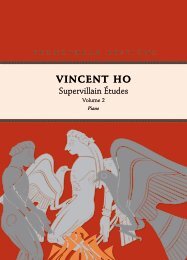Create successful ePaper yourself
Turn your PDF publications into a flip-book with our unique Google optimized e-Paper software.
Programme Notes<br />
Commissioned by Bravo Niagara! for the pre-eminent Israeli violinist Shlomo<br />
Mintz with the financial support of the Ontario Arts Council, “<strong>Menorah</strong>”<br />
is a technically demanding composition for violin and piano. The premiere<br />
took place on December 13, 2020 as a music video with violinist Marc Djokic<br />
and pianist Christina Quilico. It was presented as part of the Voices of Hope<br />
online festival commemorating the 75th anniversary of the end of the<br />
תכרב) Holocaust. It is cast in two contrasting movements, Shabbat Blessing<br />
depicting two opposite psychic patterns ”(םותי שידק) and Kaddish Yatom (תבש<br />
manifesting at times of personal and collective crisis, one of tightly holding<br />
on to something old and trusted and another of questioning it and, with<br />
it, our shared understanding of humanity and its shuttered assurances. Not<br />
being a Jew myself, it is this larger canvas that has allowed me to enter<br />
the subject of the Holocaust and document my own psychic reactions to it,<br />
particularly at a time in our collective existence when dark clouds are again<br />
assembling in the horizon and, if we do not study and learn from history, we<br />
will be condemned to repeat it.<br />
Shabbat Blessing begins with superimposed right- and left-hand pizzicatos<br />
on the violin giving way to a devotional Jewish-sounding melody. For a<br />
while, the piano accompaniment sounds like flickering stars: a cycle of<br />
‘threes’ and ‘fours’ in the high register of the instrument undisturbed by<br />
the earthbound violin melody. The cosmic number ‘seven’ is present and<br />
hidden everywhere: in the audibly rotating ‘threes’ against ‘fours’ present<br />
in the violin pizzicatos and in the right and left hands of the piano, in the<br />
hidden “digit sums” of the tempo markings (52, 43) and in the ‘three-tofour’<br />
metric modulations appearing downstream and disturbing the original<br />
peacefulness of the music. Soon, this prayerful calmness of “sevenness”<br />
gives way to impassioned and unsettled music which still looks at melodic<br />
and harmonic tradition for answers to the impasse of the moment. Finally,<br />
tradition is suppressed, and the principal tonal motifs of the violin become<br />
transformed and incorporated into atonal (twelve-tone) statements which,<br />
to me at least, represent a systemic embrace of reductionist logic at the<br />
pivotal moment when faith fails. I was thinking here of Arnold Schoenberg,<br />
the father of 20th Century musical modernism, who retorted with such<br />
rationalist means to the intolerant “classicism” of his time in order to<br />
exorcise the rampant and uncontrolled antisemitism and the ascendancy<br />
of Nazism in his home country. The soulful four-note “Jewish” motifs of<br />
the previous violin melody now become mere tetrachords: a set of nonfunctional<br />
cogs in the mechanical “communism” of the twelve-tone system.<br />
Kaddish Yatom begins with a sudden and devastating shuddering inside<br />
the low strings of the piano. From within this shuddering, the growing<br />
moans of the violin become increasingly audible. After a brief silence,<br />
spasmodic and dehumanized gestures by the two instruments break out<br />
unexpectedly, separated by silences or quiet moments. Even these quiet<br />
moments, however, (distorted tonal memories, often in tatters) serve only


















